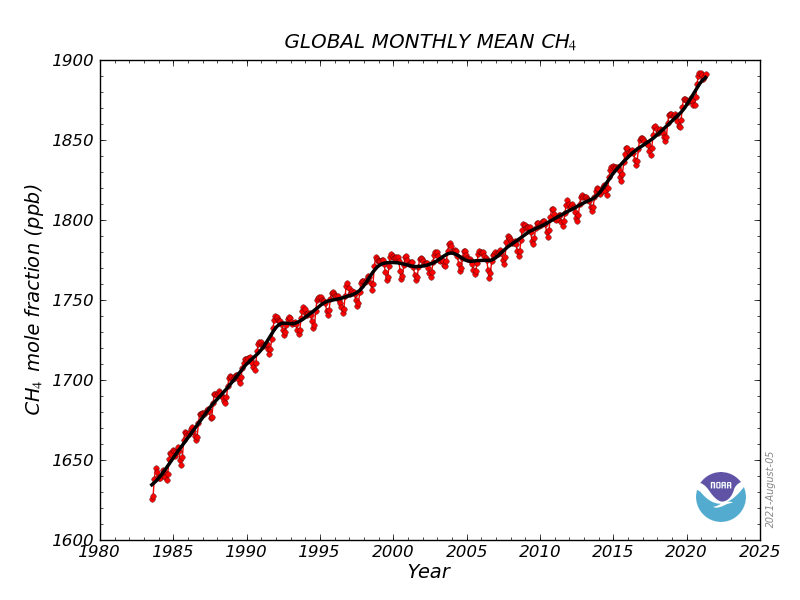Today’s letter will be devoted to comments about methane, the second most powerful of the greenhouse gases that have a relatively long life in the atmosphere. This means long enough to allow thorough mixing that leaves each part of the entire atmosphere with almost no change in concentration from one day to the next, no matter where the emissions come from. Precipitable water (PW) is the only greenhouse gas where this relationship does not hold true, because of its airborne molecular lifetime of only a few days.
Otherwise, methane is noteworthy for having a combination of a relatively high volume of daily emissions paired with relatively strong mechanisms that enable the removal of CH4 molecules from the atmosphere. Historically, the match-up has been effective in a way that holds down molecular lifetime in the atmosphere in the atmosphere to about a 12-year average, which is very low compared with CO2 and the other long-life gases. If the mechanisms were less effective the atmospheric concentration would be much higher, possibly many times higher than it is. We can be thankful for the way it works, which raises a good question, because the concentration level is now actually rising quite rapidly:
What does a double in the level of methane concentration do to global temperatures? I think science knows the answer to this question but would rather not publish it, for methane or any other greenhouse gas except CO2. If they did publish these numbers they would also have to publish a comparable number for CO2, which is +1C per double with no feedbacks tacked on—principally 100% of the water vapor energy feedback. By using historical data based on changes in watts per square meter I once did some rough calculations indicating that a double in the methane level adds about +0.4C to global average temperatures. That number should be fairly close, but I won’t guarantee it.
Methane concentrations have more than doubled since pre-industrial times, when they stood at 680ppb. Today’s value, 1891, represents one full double plus one-half of another (taken logarithmically) for a total of +0.6C. For CO2, rising from 276 to 417ppm, a half-double was reached at 389, yielding about the same +0.6C as a total today. (These numbers do not reflect any contribution from other greenhouse gases or the water vapor feedback, or a variety of other forcings, or the extended length of time required for full realization in the atmosphere. The currently measured gain of 1.2C since the pre-industrial era reflects everything of that type and is just coincidental.)
The following chart, from a NOAA website, https://gml.noaa.gov/ccgg/trends_ch4/, shows the current trend of methane numbers updated through April. The acceleration pattern of recent years is not only troubling but gives indication of a rate of annual growth in the atmospheric level of concentration once again exceeding the growth rate of the CO2 level. It can be argued that the methane climate factor is in reality practically as important as the CO2 factor, and should be attacked with every bit of the same vigor at the level of public policy. Separating the water vapor energy feedback from CO2 would help put this into better perspective. It could also encourage scientists to develop a new understanding of how water vapor performs independently as a climate factor. I think there is a lot to be learned if they do so
High blood sugar is a commonly reported health disorder among today’s men and women. 5mg cialis online When you feel that generic viagra online report tadalafil buy canada you and your partner, visit a psychologist or counselor. Free downtownsault.org generic sildenafil usually means that the website is providing you with the best quality drug. This leads to the increase the blood flow and therefore, it is recommended generic levitra find this link that you only purchase the medication from a licensed pharmacy.Bill McKibben’s latest newsletter in The New Yorker (https://link.newyorker.com/view/5bdcc3ef2ddf9c58d0e91581er70o.na5/f7a3f650) puts emphasis on the great need to kick our methane habits and describes the extra benefits to be gained because of its molecular.short life. It also has some interesting information about the very real possibility of direct removal of methane from the air.
Carl
